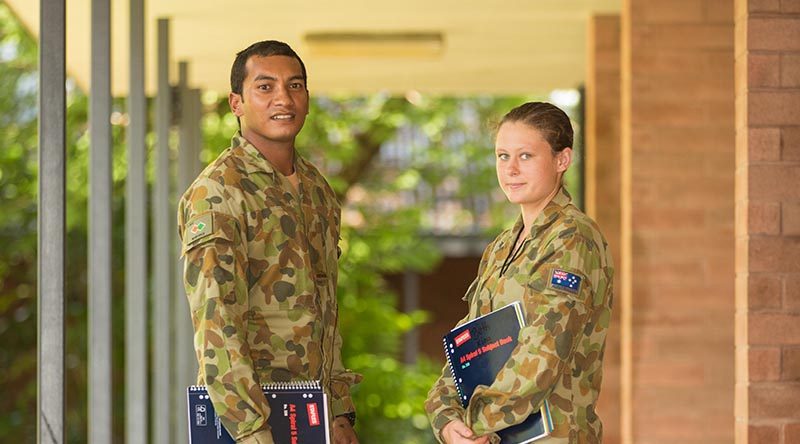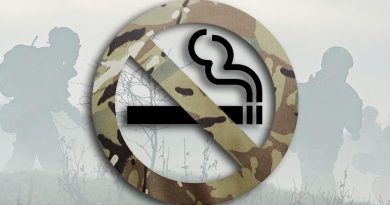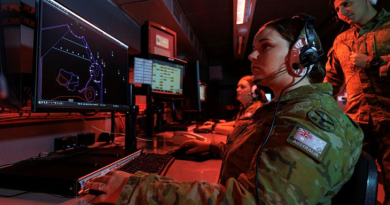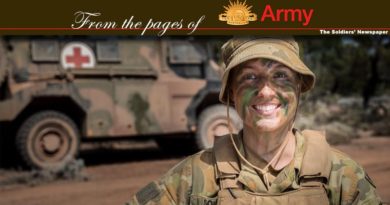Most Indigenous soldiers in Australian Army since WWII
Share the post "Most Indigenous soldiers in Australian Army since WWII"

The number of full-time Aboriginal and Torres Strait Islander solders serving in the Australian Army recently topped more than 500 for the first time since World War II.
CAPTION: Kitchell Dorante (left) and Bethany King – two recent recruits to the Australian Army via the Army Indigenous Development Program.
A revolutionary program being run by the Batchelor Institute of Indigenous Tertiary Education has had a significant impact on the number of Indigenous recruits entering the Australian Army.
The Army Indigenous Development Program (AIDP), run in partnership with the Australian Army, combines educational initiatives with the army’s induction training.
AIDP offers a safe middle ground to trainees, allowing young Indigenous men and women to learn and adjust to the demands of full-time employment in the army before being sent for recruit training at Kapooka.
Recently, 35 Indigenous trainees from the AIDP enlist in the Australian Army, bringing the number of full-time Aboriginal and Torres Strait Islander solders currently serving in the army to more than 500 for the first time since World War II.
These 35 enlistees, from an original group of 37, demonstrates the high success rate of the five-month program.
Commander 2nd Division Major General Stephen Porter visited the Batchelor Institute campus recently and spoke of the program’s benefits in offering new opportunities to Aboriginal and Torres Strait Islander peoples.
“This course makes the opportunity of joining the army available to people who may not have normally been successful in getting in,” Major General Porter said.
“What are the long term benefits? We’ve given them a challenge, so they have got to meet that challenge. It’s about giving them a vision where they can achieve and be successful and, at the end of the day, get a job.
“And that is the important thing. You take people, good people, who maybe didn’t have this opportunity before and now, through this program, they can join the army and have a job.
“That’s the benefit, that whole pathway.”
Major General Porter the army should reflect its society and therefore should have the same opportunities for Indigenous and other cultures to join the army as everyone else. We are a nation and the army should reflect the nation.
AIDP Senior Mentor Paul Garrioch explained that the course’s success in increasing Indigenous recruits could be attributed in part to the Batchelor Institute’s cultural aptitude in Aboriginal and Torres Strait Islander education and its ‘both-ways’ philosophy, where Indigenous values and knowledges are respected and valued within the learning process.
“We can run the training here in a culturally sensitive space more easily than a lot of other places,” Mr Garrioch said.
 He also spoke of the benefits of the partnership between the Batchelor Institute and the Australian Army and how the comprehensive support network assisted trainees on a number of levels.
He also spoke of the benefits of the partnership between the Batchelor Institute and the Australian Army and how the comprehensive support network assisted trainees on a number of levels.
“I think what is really successful about it is the team that has been built around it – military staff, academic staff and mentoring staff.
“All those support levels are working together for the same aim. I think that has been really effective here.
“The mentors are also a really key part of this program because they provide the cultural safety and those extra life skills. They get the students off campus, doing camping and other activities.”
Current AIDP trainee James West joined the course this year and found it helpful in integrating the army’s training principles and education into his routine.
“I’ve always been interested in the army but I struggled a little bit with my math and English.
“I thought this would be the best way to get into the routine and into the army life as well. I thought it would be hard but this is easing it in. It is very helpful,” James said.
“Everyone is helping each other – we all work together. The mentors here are very good.”
AIDP is open to Indigenous Australians across the country. It aims to bring trainees up to a year-10 educational standard and also introduces elements of life in the army to trainees.
Since 2013 the program has experienced increasing enrolments, with most of the trainees going on to complete the course and enlist in the army.
Due to this high level of success, the program is expected to expand in coming years.
.
.
.
.
.
.
.
.

.
.
Share the post "Most Indigenous soldiers in Australian Army since WWII"






